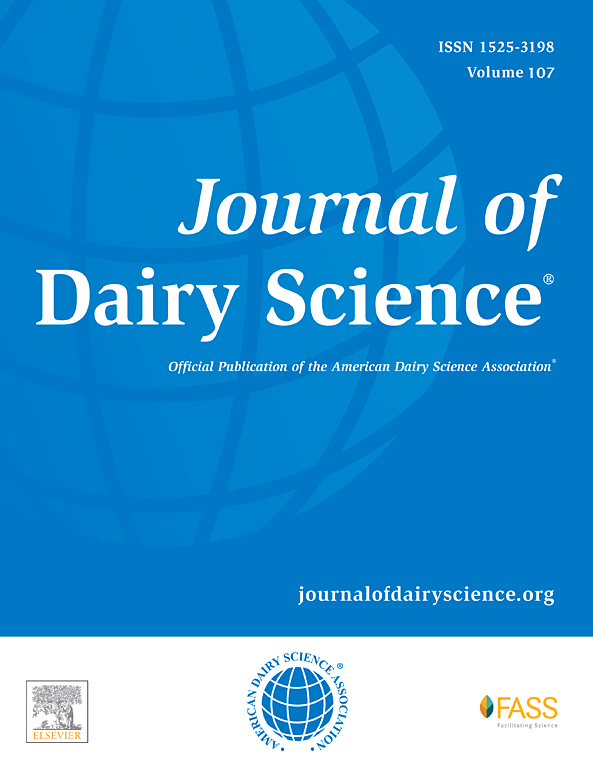紫锥菊(L.)蒙恩氏粗提物与柠檬酸联合灭活婴儿配方奶粉中分离的阪崎克罗诺杆菌。
IF 4.4
1区 农林科学
Q1 AGRICULTURE, DAIRY & ANIMAL SCIENCE
引用次数: 0
摘要
本研究旨在揭示紫锥菊(L.紫锥菊)的协同抑菌作用及其机制。蒙氏粗提物(EE)和柠檬酸(CA)对婴儿配方奶粉中阪崎克罗诺杆菌的抑制作用。测定EE对阪崎弧菌的最低抑菌浓度(MIC),并通过生长曲线和时间杀伤分析筛选EE与CA的最佳抑菌浓度(MIC)。研究了EE与CA对阪崎弧菌的协同抑制作用机制,并通过EE与CA联合使用对常见接触表面阪崎弧菌的灭活效果来评价其作为天然消毒剂的效果。结果表明,EE对阪崎弧菌的MIC值为60 mg/mL,与对照组相比,1 MIC的EE与CA (pH 3.0)联合处理对阪崎弧菌的生长曲线有显著抑制作用。时间杀伤分析结果显示,1 MIC的EE和CA (pH 3.0)联合处理30 min后,坂崎c的灭活率约为8 Log cfu/mL。与单独处理相比,EE和CA联合处理的阪崎木出现了细胞膜超极化、细胞膜完整性受损、细胞膜通透性提高、细菌蛋白和DNA水平降低、细胞内ROS含量先升高后降低、细胞形态变形和破裂等现象。当接种不锈钢、玻璃、陶瓷、聚苯乙烯、竹子和木材时,用1 MIC的EE与CA (pH 3.0)混合喷洒,处理15分钟后,约5 Log cfu/mL的阪崎弧菌被灭活。上述结果表明,EE联合CA可有效灭活从PIF中分离出的阪崎弧菌,可作为一种天然消毒剂,减少PIF生产环境或家庭中阪崎弧菌的污染。本文章由计算机程序翻译,如有差异,请以英文原文为准。
Echinacea purpurea (L.) Moench crude extract combined with citric acid inactivates Cronobacter sakazakii isolated from powdered infant formula
The objective of this study was to reveal the synergistic antibacterial activity and mechanism of Echinacea purpurea (L.) Moench crude extract (EE) and citric acid (CA) against Cronobacter sakazakii isolated from powdered infant formula (PIF). The minimum inhibitory concentration (MIC) of EE against C. sakazakii was determined, and then growth curve and time-kill analysis were used to screen the optimal antibacterial combination of 1 MIC of EE and CA. Changes in cell membrane potential, cell integrity, cell permeability, bacterial protein, DNA, and intracellular reactive oxygen species (ROS) levels, and cell morphology of C. sakazakii were used to reveal the synergistic inhibitory mechanism of EE and CA. The inactivation effect of EE in combination with CA against C. sakazakii on common contact surfaces was used to evaluate its efficacy as a natural disinfectant. The results showed that the MIC value of EE against C. sakazakii was 60 mg/mL, and the growth curve of C. sakazakii treated by 1 MIC of EE combined with CA (pH 3.0) was significantly inhibited compared with the control groups. The results of time-kill analysis showed that after combined treatment with 1 MIC of EE and CA (pH 3.0) for 30 min, approximately 8 log cfu/mL of C. sakazakii were inactivated. Cell membrane hyperpolarization, damaged cell membrane integrity, improved cell membrane permeability, decreased bacterial protein and DNA levels, increased and then decreased intracellular ROS contents, and deformed and ruptured cell morphology were found in C. sakazakii treated by EE combined with CA, and these phenomena were more pronounced than in C. sakazakii treated by EE or CA alone. When inoculated stainless steel, glass, ceramic, polystyrene, bamboo, and wood were sprayed with 1 MIC of EE combined with CA (pH 3.0) and after 15 min of treatment, approximately 5 log cfu/mL of C. sakazakii were inactivated. These findings suggest that EE combined with CA can effectively inactivate C. sakazakii isolated from PIF and can be used as a natural disinfectant to reduce the contamination of C. sakazakii in PIF production environments or households.
求助全文
通过发布文献求助,成功后即可免费获取论文全文。
去求助
来源期刊

Journal of Dairy Science
农林科学-奶制品与动物科学
CiteScore
7.90
自引率
17.10%
发文量
784
审稿时长
4.2 months
期刊介绍:
The official journal of the American Dairy Science Association®, Journal of Dairy Science® (JDS) is the leading peer-reviewed general dairy research journal in the world. JDS readers represent education, industry, and government agencies in more than 70 countries with interests in biochemistry, breeding, economics, engineering, environment, food science, genetics, microbiology, nutrition, pathology, physiology, processing, public health, quality assurance, and sanitation.
 求助内容:
求助内容: 应助结果提醒方式:
应助结果提醒方式:


